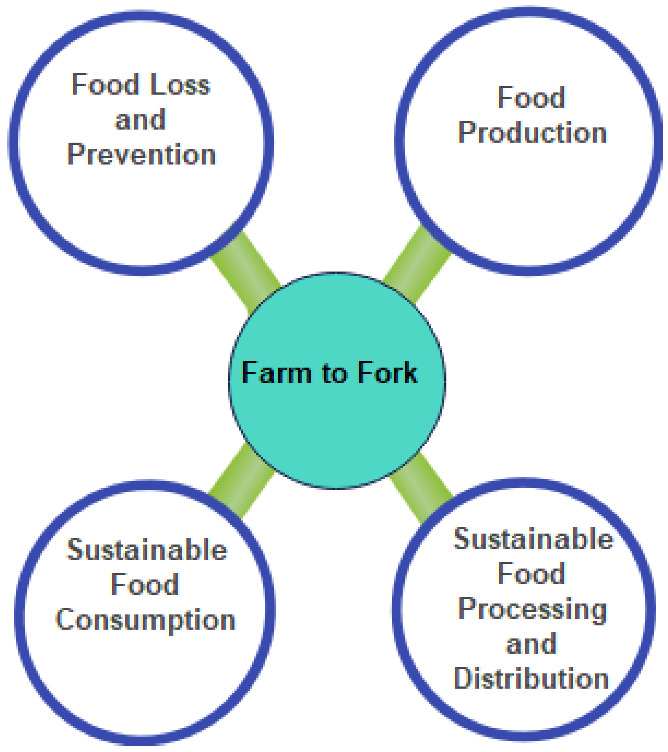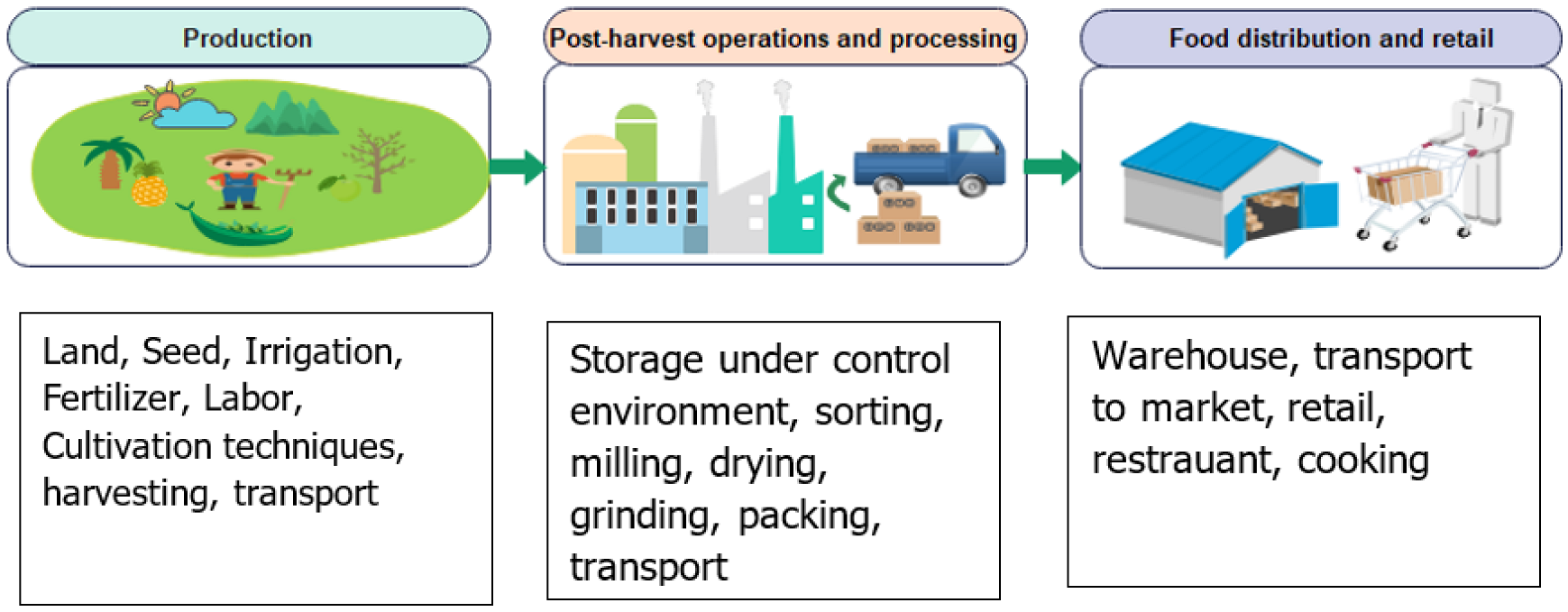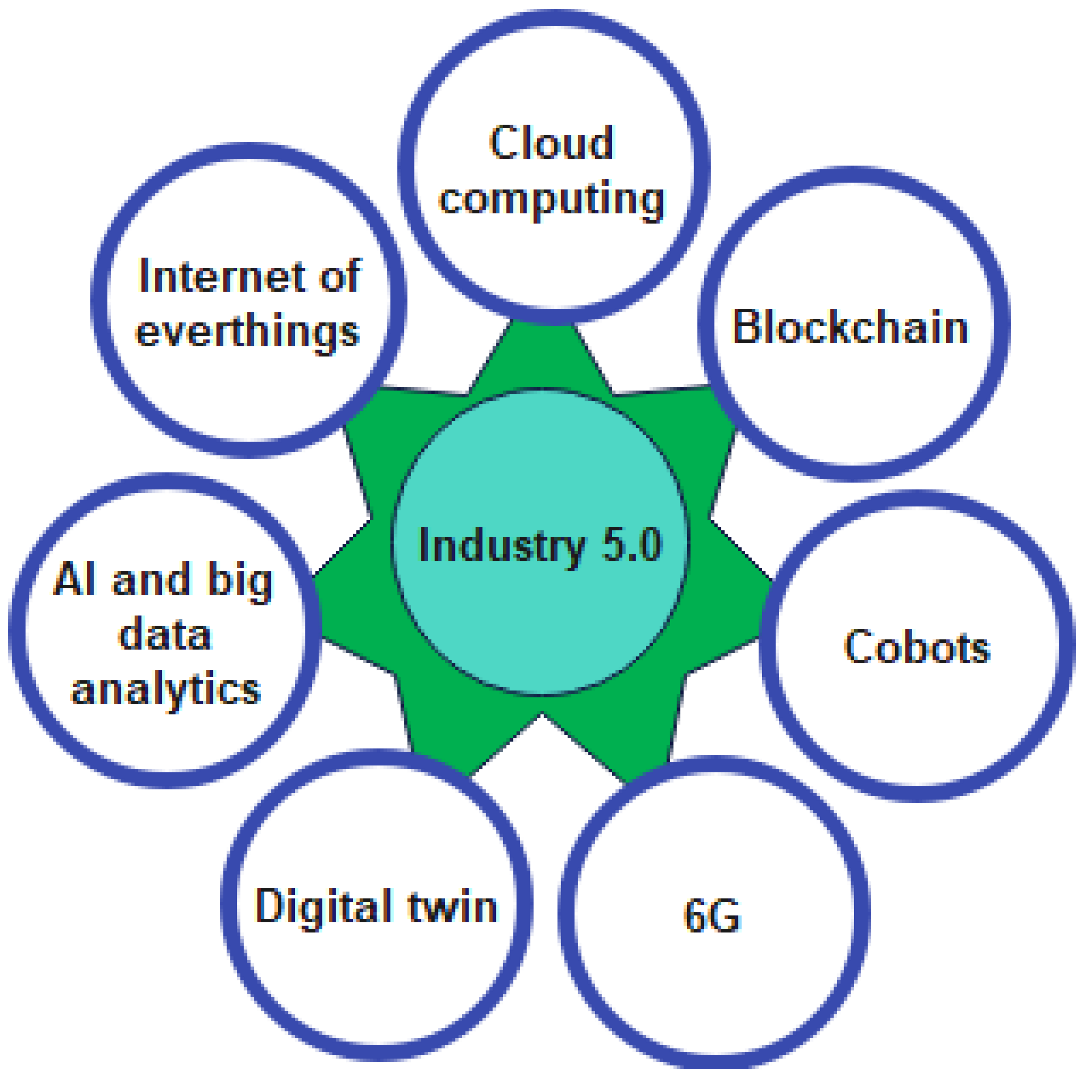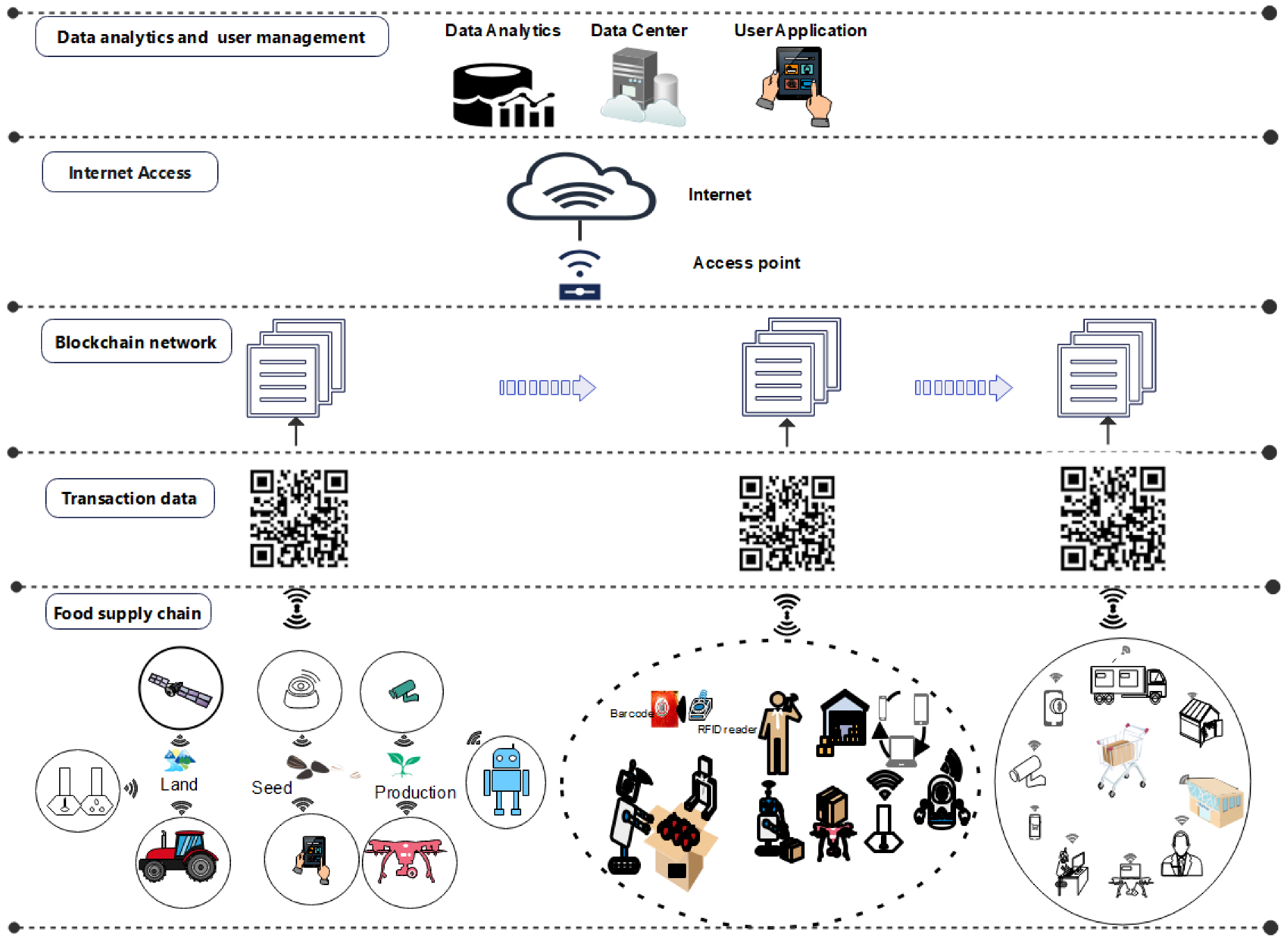Toward Better Food Security Using Concepts from Industry 5.0
Abstract
1. Introduction
2. Food System
2.1. Food Security
2.2. Food Safety and Quality
2.3. Food Authenticity and Traceability
2.4. Integrity of Food System
2.5. Food System Resilience
2.6. Risks Involved in Food Security
3. Industry 5.0 and Its Evolution
3.1. AI and Big Data Analytics
3.2. Digital Twins
3.3. Cloud Computing
3.4. Internet of Everything
3.5. Blockchain
3.6. Cobots
3.7. 6G
4. Digitalizing, Tracking, and Tracing Food Supply Chain
4.1. Agricultural Production Process
4.2. Postharvest Operations and Food Processing
4.3. Food Distribution and Retail
5. Key Enhancements to Food Supply Chain by Specific Industry 5.0 Technologies
5.1. Internet of Everything, 6G, and AI
5.2. Trace and Track Using Blockchain Technology
5.3. Digital Twin
5.4. Cobots
6. Conclusions
Author Contributions
Funding
Institutional Review Board Statement
Informed Consent Statement
Data Availability Statement
Conflicts of Interest
References
- Ejemeyovwi, J.O.; Osabohien, R.; Adeleye, B.N.; De Alwis, T. Household ICT Utilization and Food Security Nexus in Nigeria. Int. J. Food Sci. 2021, 2021, 1–10. [Google Scholar] [CrossRef] [PubMed]
- World Economic Forum. Shaping the Future of Global Food Systems: A Scenarios Analysis. World Economic Forum, 2017. Available online: https://www3.weforum.org/docs/IP/2016/NVA/WEF_FSA_FutureofGlobalFoodSystems.pdf (accessed on 24 October 2022).
- Nakai, J. Food and Agriculture Organization of the United Nations and the sustainable development goals. Sustain. Dev. 2018, 22, 3–11. [Google Scholar]
- Farm to Fork Strategy of the European Commission. Available online: https://ec.europa.eu/food/horizontal-topics/farm-fork-strategy_en (accessed on 20 April 2022).
- Varyvoda, Y.; Taren, D. Considering ecosystem services in food system resilience. Int. J. Environ. Res. Public Health 2022, 19, 3652. [Google Scholar] [CrossRef] [PubMed]
- Nasirahmadi, A.; Hensel, O. Toward the Next Generation of Digitalization in Agriculture Based on Digital Twin Paradigm. Sensors 2022, 22, 498. [Google Scholar] [CrossRef]
- Cifuentes, M.L.; Freyer, B.; Sonnino, R.; Fiala, V. Embedding sustainable diets into urban food strategies: A multi-actor approach. Geoforum 2021, 122, 11–21. [Google Scholar] [CrossRef]
- Bilali, E.H.; Callenius, C.; Strassner, C.; Probst, L. Food and nutrition security and sustainability transitions in food systems. Food Energy Secur. 2019, 8, e00154. [Google Scholar] [CrossRef]
- Barrett, C.B. Measuring Food Insecurity. Science 2010, 327, 825–828. [Google Scholar] [CrossRef]
- Bayir, B.; Charles, A.; Sekhari, A.; Ouzrout, Y. Issues and Challenges in Short Food Supply Chains: A Systematic Literature Review. Sustainability 2022, 14, 3029. [Google Scholar] [CrossRef]
- Flamini, M.; Naldi, M. Maturity of Industry 4.0: A Systematic Literature Review of Assessment Campaigns. J. Open Innov. Technol. Mark. Complex. 2022, 8, 51. [Google Scholar] [CrossRef]
- Gómez-Barroso, J.L.; Marbán-Flores, R. Telecommunications and economic development–The 20th century: The building of an evidence base. Telecommun. Policy 2020, 44, 101904. [Google Scholar] [CrossRef]
- Ingram, J.; Maye, D. What are the implications of digitalisation for agricultural knowledge? Front. Sustain. Food Syst. 2020, 4, 66. [Google Scholar] [CrossRef]
- Wolfert, S.; Ge, L.; Verdouw, C.; Bogaardt, M.-J. Big data in smart farming–a review. Agric. Syst. 2017, 153, 69–80. [Google Scholar] [CrossRef]
- Raja, V.; Krishnamoorthy, S.; Moses, J.A.; Anandharamakrishnan, C. ICT applications for the food industry. In Future Foods; Bhat, R., Ed.; Academic Press: Cambridge, MA, USA, 2022; pp. 613–626. [Google Scholar]
- Feng, Y.; Xie, L.; Chen, Q.; Zheng, L.-R. Low-Cost Printed Chipless RFID Humidity Sensor Tag for Intelligent Packaging. IEEE Sensors J. 2014, 15, 3201–3208. [Google Scholar] [CrossRef]
- Regattieri, A.; Gamberi, M.; Manzini, R. Traceability of food products: General framework and experimental evidence. J. Food Eng. 2007, 81, 347–356. [Google Scholar] [CrossRef]
- Echchakoui, S.; Barka, N. Industry 4.0 and its impact in plastics industry: A literature review. J. Ind. Inf. Integr. 2020, 20, 100172. [Google Scholar] [CrossRef]
- Lu, Y. Industry 4.0: A survey on technologies, applications and open research issues. J. Ind. Inf. Integr. 2017, 6, 1–10. [Google Scholar] [CrossRef]
- Maddikunta, P.K.R.; Pham, Q.-V.; Prabadevi, B.; Deepa, N.; Dev, K.; Gadekallu, T.R.; Ruby, R.; Liyanage, M. Industry 5.0: A survey on enabling technologies and potential applications. J. Ind. Inf. Integr. 2021, 26, 100257. [Google Scholar] [CrossRef]
- Porambage, P.; Gür, G.; Osorio, D.P.M.; Liyanage, M.; Gurtov, A.; Ylianttila, M. The roadmap to 6G security and privacy. IEEE Open J. Commun. Soc. 2021, 2, 1094–1122. [Google Scholar] [CrossRef]
- Javaid, M.; Haleem, A.; Singh, R.P.; Ambedkar, B.R.; Haq, M.I.U.; Raina, A.; Suman, R. Industry 5.0: Potential applications in COVID-19. J. Ind. Integr. Manag. 2020, 5, 507–530. [Google Scholar] [CrossRef]
- Mehdiabadi, A.; Shahabi, V.; Shamsinejad, S.; Amiri, M.; Spulbar, C.; Birau, R. Investigating Industry 5.0 and Its Impact on the Banking Industry: Requirements, Approaches and Communications. Appl. Sci. 2022, 12, 5126. [Google Scholar] [CrossRef]
- Sharma, R.; Arya, R. UAV based long range environment monitoring system with Industry 5.0 perspectives for smart city infrastructure. Comput. Ind. Eng. 2022, 168, 108066. [Google Scholar] [CrossRef]
- Akundi, A.; Euresti, D.; Luna, S.; Ankobiah, W.; Lopes, A.; Edinbarough, I. State of industry 5.0-Analysis and identification of current research trends. Appl. Syst. Innov. 2022, 5, 27. [Google Scholar] [CrossRef]
- Nahavandi, S. Industry 5.0-A human-centric solution. Sustainability 2019, 11, 4371. [Google Scholar] [CrossRef]
- Jafari, N.; Azarian, M.; Yu, H. Moving from industry 4.0 to industry 5.0: What are the implications for smart logistics? Logistics 2022, 6, 26. [Google Scholar] [CrossRef]
- Nguyen, H. Sustainable Food Systems Concept and Framework; Food and Agriculture Organization of the United Nations: Rome, Italy, 2018. [Google Scholar]
- Tendall, D.; Joerin, J.; Kopainsky, B.; Edwards, P.; Shreck, A.; Le, Q.; Kruetli, P.; Grant, M.; Six, J. Food system resilience: Defining the concept. Glob. Food Secur. 2015, 6, 17–23. [Google Scholar] [CrossRef]
- de Paulo Farias, D.; dos Santos Gomes, M.G. COVID-19 outbreak: What should be done to avoid food shortages? Trends Food Sci. Technol. 2020, 102, 291. [Google Scholar] [CrossRef]
- D’Odorico, P.; Carr, J.A.; Laio, F.; Ridolfi, L.; Vandoni, S. Feeding humanity through global food trade. Earth’s Future 2014, 2, 458–469. [Google Scholar] [CrossRef]
- Seekell, D.A.; Carr, J.; Dell’Angelo, J.; D’Odorico, P.; Fader, M.; Gephart, J.A.; Kummu, M.; Magliocca, N.; Porkka, M.; Puma, M.J.; et al. Resilience in the global food system. Environ. Res. Lett. 2017, 12, 025010. [Google Scholar] [CrossRef]
- Kneafsey, M.; Venn, L.; Schmutz, U.; Balázs, B.; Trenchard, L.; Eyden-Wood, T.; Bos, E.; Sutton, G.; Blackett, M. Short food supply chains and local food systems in the EU. A state of play of their socio-economic characteristics. JRC Sci. Policy Rep. 2013, 123, 129. [Google Scholar]
- Marusak, A.; Sadeghiamirshahidi, N.; Krejci, C.C.; Mittal, A.; Beckwith, S.; Cantu, J.; Morris, M.; Grimm, J. Resilient regional food supply chains and rethinking the way forward: Key takeaways from the COVID-19 pandemic. Agric. Syst. 2021, 190, 103101. [Google Scholar] [CrossRef]
- Hoorfar, J.; Pruggerl, R.; Butler, F.; Jordan, K. Future trends in food chain integrity. In Food Chain Integrity: A Holistic Approach to Food Traceability, Safety, Quality and Authenticity; Hoorfar, J., Jordan, K., Butler, F., Prugger, R., Eds.; Woodhead Publishing: Cambridge, UK, 2011; pp. 303–308. [Google Scholar] [CrossRef]
- FAO. Food Security. Policy Brief, June 2006(2). 2006. Available online: https://www.fao.org/fileadmin/templates/faoitaly/documents/pdf/pdf_Food_Security_Cocept_Note.pdf (accessed on 24 October 2022).
- Yeung, R.M.; Morris, J. Food safety risk: Consumer perception and purchase behaviour. Br. Food J. 2001, 103, 170–186. [Google Scholar] [CrossRef]
- Van der Meulen, B. Development of food legislation around the world. In Ensuring Global Food Safety Exploring Global Harmonization; Boisrobert, C.E., Stjepanovic, A., Oh, S., Lelieveld, H.L.M., Eds.; Academic Press: Cambridge, MA, USA, 2010; pp. 5–69. [Google Scholar]
- Fung, F.; Wang, H.-S.; Menon, S. Food safety in the 21st century. Biomed. J. 2018, 41, 88–95. [Google Scholar] [CrossRef] [PubMed]
- Haghiri, M. Consumer Choice between Food Safety and Food Quality: The Case of Farm-Raised Atlantic Salmon. Foods 2016, 5, 22. [Google Scholar] [CrossRef] [PubMed]
- Grunert, K.G. Food quality and safety: Consumer perception and demand. Eur. Rev. Agric. Econ. 2005, 32, 369–391. [Google Scholar] [CrossRef]
- FAO. Codex Alimentarius Principles for Traceability. Available online: http://www.fao.org/a.ag/againfo/themes/en/meat/quality_trace.html (accessed on 24 October 2022).
- Morrison, C. Traceability in food processing: An introduction. In Food Authenticity and Traceability; Lees, M., Ed.; Woodhead Publishing: Cambridge, UK, 2003; pp. 459–472. [Google Scholar]
- Bosona, T.; Gebresenbet, G. Food traceability as an integral part of logistics management in food and agricultural supply chain. Food Control 2013, 33, 32–48. [Google Scholar] [CrossRef]
- Pizzuti, T.; Mirabelli, G. The Global Track&Trace System for food: General framework and functioning principles. J. Food Eng. 2015, 159, 16–35. [Google Scholar] [CrossRef]
- Pearson, S.; May, D.; Leontidis, G.; Swainson, M.; Brewer, S.; Bidaut, L.; Frey, J.G.; Parr, G.; Maull, R.; Zisman, A. Are distributed ledger technologies the panacea for food traceability? Glob. Food Secur. 2019, 20, 145–149. [Google Scholar] [CrossRef]
- Golay, C. The food crisis and food security: Towards a new world food order? Int. Dev. Policy 2010, 2010, 215–232. [Google Scholar] [CrossRef]
- Motarjemi, Y. Food safety assurance systems: Essentials of crisis nanagement. In Encyclopedia of Food Safety; Motarjemi, Y., Moy, G., Todd, E., Eds.; Academic Press: Cambridge, MA, USA, 2014; pp. 322–330. [Google Scholar]
- Cottrell, R.S.; Nash, K.; Halpern, B.S.; Remenyi, T.A.; Corney, S.P.; Fleming, A.; Fulton, E.A.; Hornborg, S.; Johne, A.; Watson, R.A.; et al. Food production shocks across land and sea. Nat. Sustain. 2019, 2, 130–137. [Google Scholar] [CrossRef]
- Cullen, M. COVID-19 and the Risk to Food Supply Chains: How to Respond. 2020. Available online: http://www.Fao.Org/3/Ca8388en/CA8388EN.Pdf (accessed on 24 October 2022).
- Aung, M.M.; Chang, Y.S. Traceability in a food supply chain: Safety and quality perspectives. Food Control 2014, 39, 172–184. [Google Scholar] [CrossRef]
- Beulens, A.J.; Broens, D.-F.; Folstar, P.; Hofstede, G.J. Food safety and transparency in food chains and networks Relationships and challenges. Food Control 2005, 16, 481–486. [Google Scholar] [CrossRef]
- Zhan, Y.; Chen, K.Z. Building resilient food system amidst COVID-19: Responses and lessons from China. Agric. Syst. 2021, 190, 103102. [Google Scholar] [CrossRef]
- Schipanski, M.E.; MacDonald, G.K.; Rosenzweig, S.; Chappell, M.J.; Bennett, E.M.; Kerr, R.B.; Blesh, J.; Crews, T.; Drinkwater, L.; Lundgren, J.G.; et al. Realizing Resilient Food Systems. BioScience 2016, 66, 600–610. [Google Scholar] [CrossRef]
- Akbari, M.; Foroudi, P.; Shahmoradi, M.; Padash, H.; Parizi, Z.S.; Khosravani, A.; Ataei, P.; Cuomo, M.T. The Evolution of Food Security: Where Are We Now, Where Should We Go Next? Sustainability 2022, 14, 3634. [Google Scholar] [CrossRef]
- Gaitán-Cremaschi, D.; Klerkx, L.; Duncan, J.; Trienekens, J.H.; Huenchuleo, C.; Dogliotti, S.; Contesse, M.E.; Rossing, W.A.H. Characterizing diversity of food systems in view of sustainability transitions. A review. Agron. Sustain. Dev. 2018, 39, 1–22. [Google Scholar] [CrossRef] [PubMed]
- Xu, Z.; Elomri, A.; El Omri, A.; Kerbache, L.; Liu, H. The Compounded Effects of COVID-19 Pandemic and Desert Locust Outbreak on Food Security and Food Supply Chain. Sustainability 2021, 13, 1063. [Google Scholar] [CrossRef]
- Günther, W.A.; Mehrizi, M.H.R.; Huysman, M.; Feldberg, F. Debating big data: A literature review on realizing value from big data. J. Strat. Inf. Syst. 2017, 26, 191–209. [Google Scholar] [CrossRef]
- Rahmani, A.M.; Azhir, E.; Ali, S.; Mohammadi, M.; Ahmed, O.H.; Ghafour, M.Y.; Ahmed, S.H.; Hosseinzadeh, M. Artificial intelligence approaches and mechanisms for big data analytics: A systematic study. PeerJ Comput. Sci. 2021, 7, e488. [Google Scholar] [CrossRef]
- Pylianidis, C.; Osinga, S.; Athanasiadis, I.N. Introducing digital twins to agriculture. Comput. Electron. Agric. 2021, 184, 105942. [Google Scholar] [CrossRef]
- Verboven, P.; Defraeye, T.; Datta, A.K.; Nicolai, B. Digital twins of food process operations: The next step for food process models? Curr. Opin. Food Sci. 2020, 35, 79–87. [Google Scholar] [CrossRef]
- Tsanousa, A.; Bektsis, E.; Kyriakopoulos, C.; González, A.G.; Leturiondo, U.; Gialampoukidis, I.; Karakostas, A.; Vrochidis, S.; Kompatsiaris, I. A Review of Multisensor Data Fusion Solutions in Smart Manufacturing: Systems and Trends. Sensors 2022, 22, 1734. [Google Scholar] [CrossRef] [PubMed]
- da Costa, V.F.; Oliveira, L.; de Souza, J. Internet of Everything (IoE) Taxonomies: A Survey and a Novel Knowledge-Based Taxonomy. Sensors 2021, 21, 568. [Google Scholar] [CrossRef] [PubMed]
- Azizi, N.; Malekzadeh, H.; Akhavan, P.; Haass, O.; Saremi, S.; Mirjalili, S. IoT–Blockchain: Harnessing the Power of Internet of Thing and Blockchain for Smart Supply Chain. Sensors 2021, 21, 6048. [Google Scholar] [CrossRef] [PubMed]
- Menon, S.; Jain, K. Blockchain Technology for Transparency in Agri-Food Supply Chain: Use Cases, Limitations, and Future Directions. IEEE Trans. Eng. Manag. 2021, 2021, 1–15. [Google Scholar] [CrossRef]
- Mahdi, M.N.; Ahmad, A.R.; Qassim, Q.S.; Natiq, H.; Subhi, M.A.; Mahmoud, M. From 5G to 6G Technology: Meets Energy, Internet-of-Things and Machine Learning: A Survey. Appl. Sci. 2021, 11, 8117. [Google Scholar] [CrossRef]
- Akhtar, M.W.; Hassan, S.A.; Ghaffar, R.; Jung, H.; Garg, S.; Hossain, M.S. The shift to 6G communications: Vision and requirements. Human-centric Comput. Inf. Sci. 2020, 10, 53. [Google Scholar] [CrossRef]
- Valous, N.; Sun, D.-W. Image processing techniques for computer vision in the food and beverage industries. In Computer Vision Technology in the Food and Beverage Industries; Sun, D.-W., Ed.; Woodhad Publishing: Cambridge, UK, 2012; pp. 97–129. [Google Scholar]
- Adhikari, R.; Li, C.; Kalbaugh, K.; Nemali, K. A low-cost smartphone controlled sensor based on image analysis for estimating whole-plant tissue nitrogen (N) content in floriculture crops. Comput. Electron. Agric. 2020, 169, 105173. [Google Scholar] [CrossRef]
- Albiero, D. Agricultural Robotics: A Promising Challenge. Curr. Agric. Res. J. 2019, 7, 1–3. [Google Scholar] [CrossRef]
- Mao, S.; Li, Y.; Ma, Y.; Zhang, B.; Zhou, J.; Wang, K. Automatic cucumber recognition algorithm for harvesting robots in the natural environment using deep learning and multi-feature fusion. Comput. Electron. Agric. 2020, 170, 105254. [Google Scholar] [CrossRef]
- Deng, L.; Mao, Z.; Li, X.; Hu, Z.; Duan, F.; Yan, Y. UAV-based multispectral remote sensing for precision agriculture: A comparison between different cameras. ISPRS J. Photogramm. Remote Sens. 2018, 146, 124–136. [Google Scholar] [CrossRef]
- Boukoberine, M.N.; Zhou, Z.; Benbouzid, M. A critical review on unmanned aerial vehicles power supply and energy management: Solutions, strategies, and prospects. Appl. Energy 2019, 255, 113823. [Google Scholar] [CrossRef]
- Prodanović, R.; Rančić, D.; Vulić, I.; Zorić, N.; Bogićević, D.; Ostojić, G.; Sarang, S.; Stankovski, S. Wireless Sensor Network in Agriculture: Model of Cyber Security. Sensors 2020, 20, 6747. [Google Scholar] [CrossRef] [PubMed]
- Yam, K. Intelligent packaging to enhance food safety and quality. In Emerging Food Packaging Technologies; Yam, K.L., Lee, D.S., Eds.; Woodhead Publising: Cambridge, UK, 2012; pp. 137–152. [Google Scholar]
- Kakani, V.; Nguyen, V.H.; Kumar, B.P.; Kim, H.; Pasupuleti, V.R. A critical review on computer vision and artificial intelligence in food industry. J. Agric. Food Res. 2020, 2, 100033. [Google Scholar] [CrossRef]
- Lind, R.; Murhed, A. Computer vision in food processing: An overview. In Computer Vision Technology in the Food and Beverage Industries; Da-Wen, S., Ed.; Woodhead Publishing: Cambridge, UK, 2012; pp. 133–149. [Google Scholar]
- Bader, F.; Rahimifard, S. Challenges for industrial robot applications in food manufacturing. In Proceedings of the 2nd International Symposium on Computer Science and Intelligent Control, Stockholm, Sweden, 21–23 September 2018. [Google Scholar]
- Duong, L.N.; Al-Fadhli, M.; Jagtap, S.; Bader, F.; Martindale, W.; Swainson, M.; Paoli, A. A review of robotics and autonomous systems in the food industry: From the supply chains perspective. Trends Food Sci. Technol. 2020, 106, 355–364. [Google Scholar] [CrossRef]
- Khan, Z.; Khalid, A.; Iqbal, J. Towards realizing robotic potential in future intelligent food manufacturing systems. Innov. Food Sci. Emerg. Technol. 2018, 48, 11–24. [Google Scholar] [CrossRef]
- Guiochet, J.; Machin, M.; Waeselynck, H. Safety-critical advanced robots: A survey. Robot. Auton. Syst. 2017, 94, 43–52. [Google Scholar] [CrossRef]
- Bekele, B. Review on factors affecting postharvest quality of fruits. J. Plant Sci. Res. 2018, 5, 180. [Google Scholar]
- Bhat, S.A.; Huang, N.-F.; Sofi, I.B.; Sultan, M. Agriculture-Food Supply Chain Management Based on Blockchain and IoT: A Narrative on Enterprise Blockchain Interoperability. Agriculture 2021, 12, 40. [Google Scholar] [CrossRef]
- Vlahovic, N.; Knezevic, B.; Sabolic, M. Overview of recent IT technologies in retail supply chains. Paper presented at the 2015: Recent Advances on Business, Economics and Development. In Proceedings of the 7th International Conference on Applied Economics, Business and Developement (AEBD’15), Budapest, Hungary, 12–14 December 2015. [Google Scholar]
- Hobbs, J.E. Food supply chains during the COVID-19 pandemic. Can. J. Agric. Econ./Rev. Can. D’agroeconomie 2020, 68, 171–176. [Google Scholar] [CrossRef]
- Toorajipour, R.; Sohrabpour, V.; Nazarpour, A.; Oghazi, P.; Fischl, M. Artificial intelligence in supply chain management: A systematic literature review. J. Bus. Res. 2021, 122, 502–517. [Google Scholar] [CrossRef]
- Pojić, M.M.; Mastilović, J.S. Near infrared spectroscopy-advanced analytical tool in wheat breeding, trade, and processing. Food Bioprocess Technol. 2013, 6, 330–352. [Google Scholar] [CrossRef]
- Min, H. Artificial intelligence in supply chain management: Theory and applications. Int. J. Logist. Res. Appl. 2010, 13, 13–39. [Google Scholar] [CrossRef]
- Duysak, H.; Yigit, E. Machine learning based quantity measurement method for grain silos. Measurement 2020, 152, 107279. [Google Scholar] [CrossRef]
- Xue, H.; Jiang, C.; Cai, B.; Yuan, Y. Research on demand forecasting of retail supply chain emergency logistics based on NRS-GA-SVM. In Proceedings of the 2018 Chinese Control and Decision Conference (CCDC), Shenyang, China, 9–11 June 2018; pp. 3647–3652. [Google Scholar] [CrossRef]
- Ni, D.; Xiao, Z.; Lim, M.K. A systematic review of the research trends of machine learning in supply chain management. Int. J. Mach. Learn. Cybern. 2020, 11, 1463–1482. [Google Scholar] [CrossRef]
- Bouzembrak, Y.; Klüche, M.; Gavai, A.; Marvin, H.J. Internet of Things in food safety: Literature review and a bibliometric analysis. Trends Food Sci. Technol. 2019, 94, 54–64. [Google Scholar] [CrossRef]
- Usman, M.; Ansari, S.; Taha, A.; Zahid, A.; Abbasi, Q.H.; Imran, M.A. Terahertz-Based Joint Communication and Sensing for Precision Agriculture: A 6G Use-Case. Front. Commun. Networks 2022, 3, 836506. [Google Scholar] [CrossRef]
- Leng, K.; Jin, L.; Shi, W.; Van Nieuwenhuyse, I. Research on agricultural products supply chain inspection system based on internet of things. Clust. Comput. 2019, 22, 8919–8927. [Google Scholar] [CrossRef]
- Jha, K.; Doshi, A.; Patel, P.; Shah, M. A comprehensive review on automation in agriculture using artificial intelligence. Artif. Intell. Agric. 2019, 2, 1–12. [Google Scholar] [CrossRef]
- Choi, T.-M. Mobile-App-Online-Website Dual Channel Strategies: Privacy Concerns, E-Payment Convenience, Channel Relationship, and Coordination. IEEE Trans. Syst. Man. Cybern. Syst. 2020, 51, 7008–7016. [Google Scholar] [CrossRef]
- Chen, T.; Ding, K.; Hao, S.; Li, G.; Qu, J. Batch-based traceability for pork: A mobile solution with 2D barcode technology. Food Control 2020, 107, 106770. [Google Scholar] [CrossRef]
- Kosior, K. Digital Transformation in the Agri-Food Sector–Opportunities and Challenges. Ann. Pol. Assoc. Agric. Agribus. Econ. 2018, XX, 98–104. [Google Scholar] [CrossRef]
- Zhao, Y.; Bacao, F. What factors determining customer continuingly using food delivery apps during 2019 novel coronavirus pandemic period? Int. J. Hosp. Manag. 2020, 91, 102683. [Google Scholar] [CrossRef] [PubMed]
- Bamburry, D. Drones: Designed for Product Delivery, Revisited. Des. Manag. Rev. 2015, 26, 40–48. [Google Scholar] [CrossRef]
- Pugliese, L.D.P.; Guerriero, F.; Macrina, G. Using drones for parcels delivery process. Procedia Manuf. 2020, 42, 488–497. [Google Scholar] [CrossRef]
- Astill, J.; Dara, R.A.; Campbell, M.; Farber, J.M.; Fraser, E.D.; Sharif, S.; Yada, R.Y. Transparency in food supply chains: A review of enabling technology solutions. Trends Food Sci. Technol. 2019, 91, 240–247. [Google Scholar] [CrossRef]
- Zhao, S.; Li, S.; Yao, Y. Blockchain Enabled Industrial Internet of Things Technology. IEEE Trans. Comput. Soc. Syst. 2019, 6, 1442–1453. [Google Scholar] [CrossRef]
- Selvakumar, G.; Hemalatha, S. A study on integrating IoT Applications with Blockchain. In Proceedings of the 2019 International Conference on Computer Communication and Informatics (ICCCI), Coimbatore, India, 23–25 January 2019. [Google Scholar]
- Kamilaris, A.; Fonts, A.; Prenafeta-Boldύ, F.X. The rise of blockchain technology in agriculture and food supply chains. Trends Food Sci. Technol. 2019, 91, 640–652. [Google Scholar] [CrossRef]
- Leng, K.; Bi, Y.; Jing, L.; Fu, H.-C.; Van Nieuwenhuyse, I. Research on agricultural supply chain system with double chain architecture based on blockchain technology. Futur. Gener. Comput. Syst. 2018, 86, 641–649. [Google Scholar] [CrossRef]
- Demestichas, K.; Peppes, N.; Alexakis, T.; Adamopoulou, E. Blockchain in Agriculture Traceability Systems: A Review. Appl. Sci. 2020, 10, 4113. [Google Scholar] [CrossRef]
- Maslova, A. Growing the Garden: How to Use Blockchain in Agriculture. Available online: https://cointelegraph.com/news/growing-the-garden-how-to-use-blockchain-in-agriculture (accessed on 24 October 2022).
- Kouhizadeh, M.; Saberi, S.; Sarkis, J. Blockchain technology and the sustainable supply chain: Theoretically exploring adoption barriers. Int. J. Prod. Econ. 2021, 231, 107831. [Google Scholar] [CrossRef]
- Carrefour. The Food Blockchain. Available online: https://www.carrefour.com/en/group/food-transition/food-blockchain (accessed on 24 October 2022).
- Olsen, P.; Borit, M.; Syed, S. Applications, Limitations, Costs, and Benefits Related to the Use of Blockchain Technology in the Food Industry. Nofima Rapp. 2019. Available online: https://nofima.brage.unit.no/nofima-xmlui/handle/11250/2586121 (accessed on 24 October 2022).
- Botín-Sanabria, D.M.; Mihaita, A.-S.; Peimbert-García, R.E.; Ramírez-Moreno, M.A.; Ramírez-Mendoza, R.A.; Lozoya-Santos, J.d.J. Digital twin rechnology challenges and applications: A comprehensive review. Remote Sens. 2022, 14, 1335. [Google Scholar] [CrossRef]
- Grobbelaar, W.; Verma, A.; Shukla, V.K. Analyzing Human Robotic Interaction in the Food Industry. J. Physics Conf. Ser. 2021, 1714, 012032. [Google Scholar] [CrossRef]









Publisher’s Note: MDPI stays neutral with regard to jurisdictional claims in published maps and institutional affiliations. |
© 2022 by the authors. Licensee MDPI, Basel, Switzerland. This article is an open access article distributed under the terms and conditions of the Creative Commons Attribution (CC BY) license (https://creativecommons.org/licenses/by/4.0/).
Share and Cite
Guruswamy, S.; Pojić, M.; Subramanian, J.; Mastilović, J.; Sarang, S.; Subbanagounder, A.; Stojanović, G.; Jeoti, V. Toward Better Food Security Using Concepts from Industry 5.0. Sensors 2022, 22, 8377. https://doi.org/10.3390/s22218377
Guruswamy S, Pojić M, Subramanian J, Mastilović J, Sarang S, Subbanagounder A, Stojanović G, Jeoti V. Toward Better Food Security Using Concepts from Industry 5.0. Sensors. 2022; 22(21):8377. https://doi.org/10.3390/s22218377
Chicago/Turabian StyleGuruswamy, Selvakumar, Milica Pojić, Jayashree Subramanian, Jasna Mastilović, Sohail Sarang, Arumugam Subbanagounder, Goran Stojanović, and Varun Jeoti. 2022. "Toward Better Food Security Using Concepts from Industry 5.0" Sensors 22, no. 21: 8377. https://doi.org/10.3390/s22218377
APA StyleGuruswamy, S., Pojić, M., Subramanian, J., Mastilović, J., Sarang, S., Subbanagounder, A., Stojanović, G., & Jeoti, V. (2022). Toward Better Food Security Using Concepts from Industry 5.0. Sensors, 22(21), 8377. https://doi.org/10.3390/s22218377








